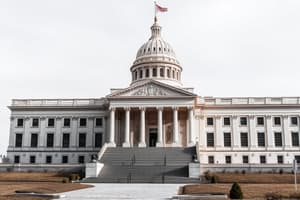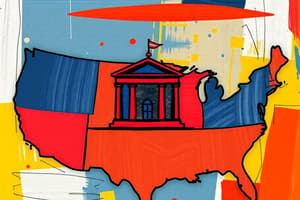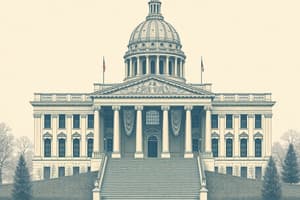Podcast
Questions and Answers
What is the primary purpose of the U.S. Constitution?
What is the primary purpose of the U.S. Constitution?
- To establish the structure and powers of the federal government (correct)
- To define the duties of the military
- To outline the right of states to govern independently
- To promote international treaties
Which article of the U.S. Constitution outlines the powers of the Legislative Branch?
Which article of the U.S. Constitution outlines the powers of the Legislative Branch?
- Article III
- Article I (correct)
- Article II
- Article IV
What power is specifically granted to the president in Article II of the U.S. Constitution?
What power is specifically granted to the president in Article II of the U.S. Constitution?
- To raise taxes
- To declare war
- To conduct foreign affairs (correct)
- To create laws
What clause requires states to respect the laws and decisions of other states?
What clause requires states to respect the laws and decisions of other states?
How can amendments to the U.S. Constitution be proposed?
How can amendments to the U.S. Constitution be proposed?
What does the Supremacy Clause in Article VI establish?
What does the Supremacy Clause in Article VI establish?
What is one of the powers of the Judicial Branch outlined in Article III?
What is one of the powers of the Judicial Branch outlined in Article III?
Who is responsible for enforcing federal laws according to the Constitution?
Who is responsible for enforcing federal laws according to the Constitution?
How many states were required to ratify the Constitution for it to go into effect?
How many states were required to ratify the Constitution for it to go into effect?
Which amendment protects individuals from self-incrimination?
Which amendment protects individuals from self-incrimination?
What is the minimum age requirement to serve as a senator?
What is the minimum age requirement to serve as a senator?
Which branch of government is responsible for enforcing laws?
Which branch of government is responsible for enforcing laws?
What power does Congress NOT possess?
What power does Congress NOT possess?
Which amendment provides the right to bear arms?
Which amendment provides the right to bear arms?
What is a key feature of the Articles of Confederation compared to the U.S. Constitution?
What is a key feature of the Articles of Confederation compared to the U.S. Constitution?
What does the system of checks and balances ensure?
What does the system of checks and balances ensure?
Which amendment addresses excessive bail and cruel and unusual punishment?
Which amendment addresses excessive bail and cruel and unusual punishment?
Which of the following is NOT a power reserved for the federal government?
Which of the following is NOT a power reserved for the federal government?
What is the term length for members of the House of Representatives?
What is the term length for members of the House of Representatives?
What is one major responsibility of the Judicial Branch?
What is one major responsibility of the Judicial Branch?
How many justices serve on the Supreme Court?
How many justices serve on the Supreme Court?
Which body approves presidential appointments to the Cabinet?
Which body approves presidential appointments to the Cabinet?
What method can Congress use to propose amendments to the Constitution?
What method can Congress use to propose amendments to the Constitution?
Flashcards
What is the U.S. Constitution?
What is the U.S. Constitution?
The U.S. Constitution is the main document that established the framework of the United States government. It defines the roles and powers of the three branches of government: legislative, executive, and judicial. It also outlines the relationship between the federal government and states.
How many articles are in the U.S. Constitution?
How many articles are in the U.S. Constitution?
The Constitution is divided into seven articles, each outlining a specific aspect of the government.
What is the role of the Legislative Branch (Congress)?
What is the role of the Legislative Branch (Congress)?
The legislative branch is made up of Congress, which is divided into the Senate and the House of Representatives. Their main job is to make laws.
What is the role of the Executive Branch (President)?
What is the role of the Executive Branch (President)?
Signup and view all the flashcards
What is the role of the Judicial Branch (Courts)?
What is the role of the Judicial Branch (Courts)?
Signup and view all the flashcards
What is the Full Faith and Credit Clause?
What is the Full Faith and Credit Clause?
Signup and view all the flashcards
What is the Supremacy Clause?
What is the Supremacy Clause?
Signup and view all the flashcards
How can the Constitution be amended?
How can the Constitution be amended?
Signup and view all the flashcards
Bill of Rights
Bill of Rights
Signup and view all the flashcards
Ratification
Ratification
Signup and view all the flashcards
Federalism
Federalism
Signup and view all the flashcards
Judicial Review
Judicial Review
Signup and view all the flashcards
Checks and Balances
Checks and Balances
Signup and view all the flashcards
Legislative Branch
Legislative Branch
Signup and view all the flashcards
Executive Branch
Executive Branch
Signup and view all the flashcards
Judicial Branch
Judicial Branch
Signup and view all the flashcards
Articles of Confederation
Articles of Confederation
Signup and view all the flashcards
President
President
Signup and view all the flashcards
Senate Majority Leader
Senate Majority Leader
Signup and view all the flashcards
Speaker of the House
Speaker of the House
Signup and view all the flashcards
Cabinet
Cabinet
Signup and view all the flashcards
Supreme Court
Supreme Court
Signup and view all the flashcards
22nd Amendment
22nd Amendment
Signup and view all the flashcards
Study Notes
U.S. Constitution (1787-1791)
- The U.S. Constitution is the foundational document of the U.S. government.
- It outlines the structure and powers of the three branches of government.
- It defines the relationship between the federal and state governments.
- The Constitution was written in 1787 and ratified in 1788.
- The Bill of Rights (first 10 amendments) was added in 1791 to protect individual liberties.
Articles of the U.S. Constitution
- Article I: Legislative Branch (Congress).
- Establishes Congress made up of the Senate and House of Representatives.
- Grants Congress powers to make laws, regulate commerce, declare war, and collect taxes.
- Defines the process for lawmaking and qualifications for representatives/senators.
- Article II: Executive Branch (President).
- Establishes the presidency and outlines presidential powers/responsibilities.
- President is Commander-in-Chief, conducts foreign affairs, negotiates treaties (Senate approval), and enforces laws.
- Can veto laws, appoint judges, and grant pardons.
- Article III: Judicial Branch (Courts).
- Establishes the Supreme Court and lower courts.
- Outlines judicial powers, including interpreting laws and resolving disputes.
- Judges have lifetime appointments.
- Article IV: The States.
- Outlines the relationship between states and federal government, respecting each other's laws, and addressing new state admission.
- Article V: Amendments.
- Specifies the process for amending the Constitution (2/3 majority of Congress OR convention, 3/4 of states approval).
- Article VI: The Supremacy Clause.
- Establishes the Constitution as the supreme law of the land, overriding state laws.
- Requires oaths of office and no religious tests for holders of offices.
- Article VII: Ratification.
- Details the ratification process (approval from 9 states required).
Bill of Rights (Amendments 1-10)
- Amendment I: Freedom of speech, press, religion, assembly, and petition.
- Amendment II: Right to keep and bear arms.
- Amendment III: Protection from quartering of soldiers.
- Amendment IV: Protection from unreasonable searches and seizures.
- Amendment V: Protects against self-incrimination, double jeopardy, and guarantees due process/eminent domain.
- Amendment VI: Right to a speedy trial, impartial jury, and legal counsel.
- Amendment VII: Right to a trial by jury in civil cases.
- Amendment VIII: Protection from cruel and unusual punishment and excessive bail.
- Amendment IX: Rights not specifically listed are still protected.
- Amendment X: Powers not given to the federal government belong to states or the people.
Office Requirements
- President: At least 35 years old, natural-born citizen, lived in the U.S. for at least 14 years. Two-term limit.
- Vice President: Same requirements as president.
- Cabinet Members: Appointed by the president, Senate approval.
- House of Representatives: At least 25 years old, U.S. citizen for 7 years, resident of the state. Two-year terms.
- Senate: At least 30 years old, U.S. citizen for 9 years, resident of the state. Six-year terms.
Branch Powers/Responsibilities
- Legislative (Congress): Makes laws, declares war, overrides vetoes, impeachment power, approves treaties/appointments.
- Executive (President): Enforces laws, vetoes, Commander-in-Chief, appoints judges/Cabinet, negotiates treaties, grants pardons.
- Judicial (Courts): Interprets laws, declares laws unconstitutional (judicial review), resolves disputes.
Checks and Balances
- Each branch has some measure of influence over the others; no one branch is too powerful.
- Legislative checks on Executive: override vetoes, impeach.
- Executive checks on Legislative: veto power.
- Judicial checks on Executive and Legislative: declare laws unconstitutional.
Federalism
- Division of power between federal and state governments.
- Federal Powers: declare war, regulate commerce, military.
- State Powers: education, elections, local governments.
- Shared Powers: taxation, law enforcement, courts.
Articles of Confederation
- First U.S. governing document (1781).
- Weak central government, most power to states.
- Key weaknesses: No power to tax, no executive branch, no national judiciary, etc.
Constitution vs. Articles of Confederation
- Constitution: Stronger central government, defined legislative (bicameral), executive (president), and judicial branches, power to tax, stronger amendment process.
- Articles: Weak central government, unicameral legislature, no executive/judicial branch, unanimous consent needed for amendments.
Branch Leaders/Numbers
- Legislative: Senate (100 senators), House of Representatives (435 members), led by the Vice President and Senate Majority Leader, Speaker of the House.
- Executive: President (1), Vice President (1), Cabinet (various members).
- Judicial: Supreme Court (9 justices), Chief Justice, lower courts (many judges).
Important Events (1787-1791)
- 1787: Constitutional Convention
- 1788: Constitution ratified (New Hampshire)
- 1789: Judiciary Act established federal judiciary
- 1790: First Census
- 1791: Bill of Rights ratified.
Studying That Suits You
Use AI to generate personalized quizzes and flashcards to suit your learning preferences.




